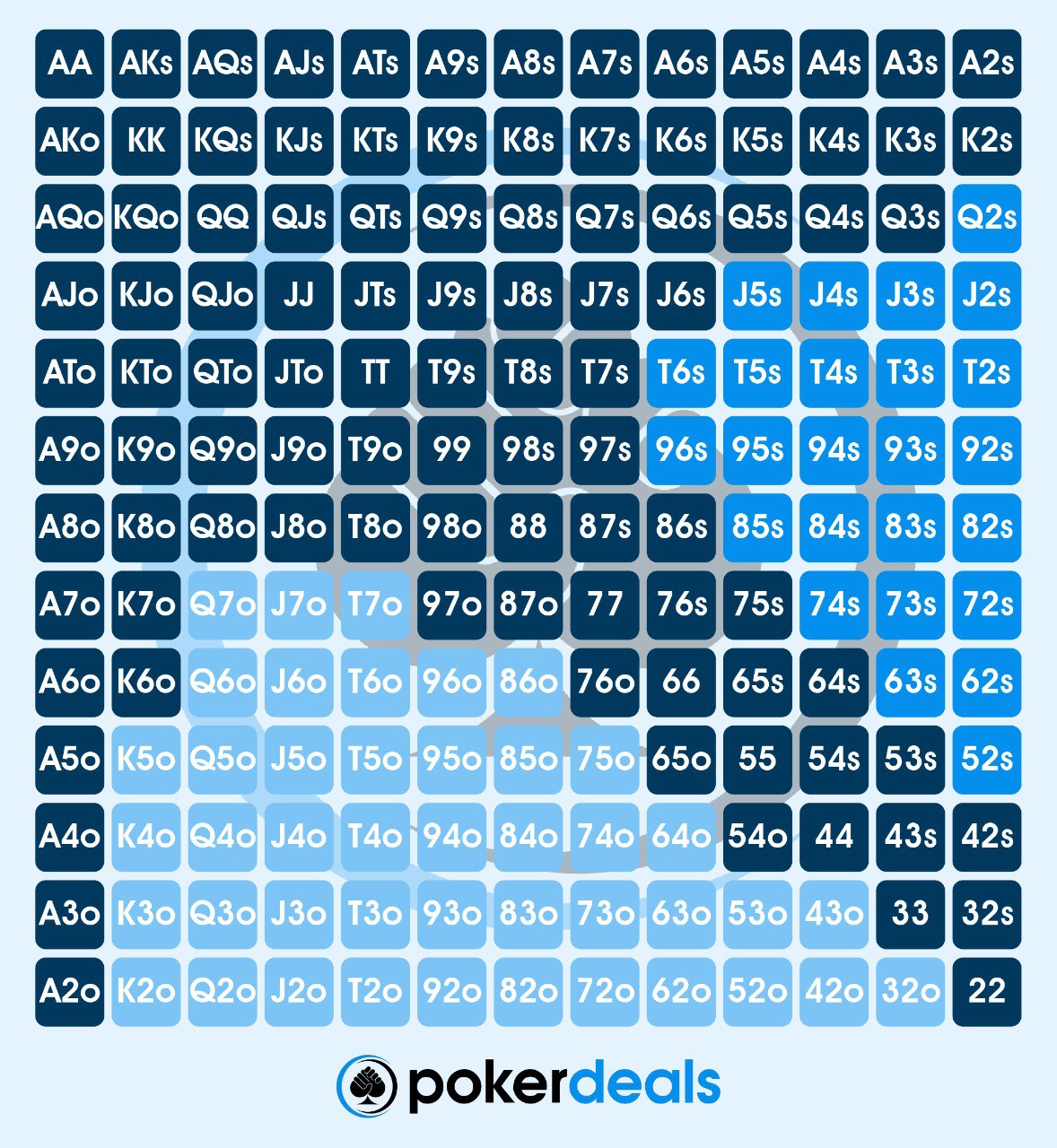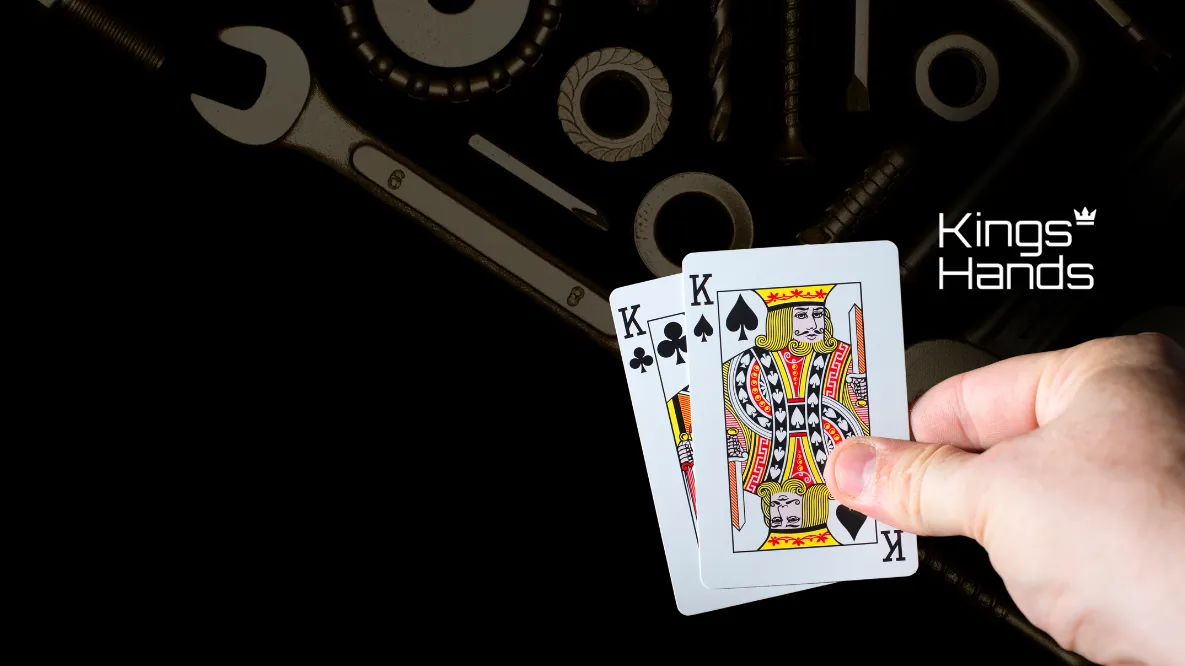We’re finally here – the most profitable position at the table, and the position where we can play the most hands; the Button.
However, despite how strong the button position is, we can’t open 100% of our hands and expect to be profitable, so we need to construct an opening range that takes advantage of the position without going overboard. In this article, we’ll take a look at how you should construct a button opening range, how to adjust based on your table dynamics, and much more.
What is the Button Position?
The Button position is the position to the left of the Cutoff position and to the right of the Small Blind position. At a nine-handed table, it is the seventh position to act preflop. It is referred to as the “Button” position, as this position is marked by a dealer button, which moves one position to the left at the end of every hand.

How Should You Play From the Button?
From every other position at the table, we’ve had to limit our opening range based on preflop or postflop disadvantages; we’ve got too many people to act after us, we’re likely going to be out of position postflop, etc. etc. However, we’re now playing from the button where we’re guaranteed to be in position postflop, and there are only two players left to act after us.
These advantages mean we need to raise an extremely wide range of hands, the widest of any position at the table. If we don’t play a wide range from the button, we’re missing out on a number of profitable situations and drastically limiting our win rate. A good player can win over 25bb/100 from the button, so playing even 20% fewer hands from this position and missing out on the potential win rate could be the difference between being a winning player or a losing player.
How Do We Construct a Button Opening Range?
So, how exactly do we go about constructing our widest preflop opening range? Playing from early position was simple, as we could stick to a tight, strong range and we were set. Even as we moved around the table, there were obvious hands that we could add to our range to widen it. But now, on the button, we need to raise a really wide range to take advantage of our position while at the same time avoiding playing too wide of a range!
Like every other new position we’ve covered, we recommend starting with the previous position’s opening range and building it up from there. The biggest gap that you can see when looking at the CO opening range is the off-suit Ax and Kx hands. We can start to add more of these into our range, as we get the benefit of playing in position with only two players left to act behind us.
We can also add more suited hands into our range, including more suited Kx, Qx, and Jx hands, as well as a number of semi-connected suited hands. Being in position with the betting lead, we get the benefit of deciding whether or not to c-bet, and likely take the hand down postflop, or check back and realise our equity.
Being able to realise equity with marginal hands is one of the reasons why we’re able to profitably play a lot of hands from the button.
Button Base Opening Range
At a nine-handed cash game table with 100bb, we recommend that your baseline Button opening range should look something like this:
52.64% – 22+, A2s+, K2s+, Q3s+, J6s+, T7s+, 97s+, 86s+, 75s+, 64s+, 53s+, 42s+, 32s, A2o+, K6o+, Q8o+, J8o+, T8o+, 97o+, 87o, 76o, 65o, 54o

This is by far the biggest jump in the number of hands played, as we see a nearly 20% increase from the CO to the BTN. One of the reasons for that is the ability to play far more offsuit hands from the button compared to the Cutoff. As we’re guaranteed to be in position, we’re better able to play offsuit hands as we are extremely likely to realise the majority of our equity.
Our usual worry about postflop imbalance is negated by the fact that we will always be in position postflop, as well as by the fact that the big blind needs to defend a wide range against our preflop opens. If they fold too often, we’ll print money by opening our wide range of hands, which means they’re forced to defend with a wide calling range.
As their range is also wide, they will find it harder to defend postflop against our c-bets and will be forced into check/folding more often. Even if we don’t c-bet the flop, we get to see the turn for free and realise the majority of our equity. The combination of these two factors allows us to play a wide range comprised of both suited and offsuit hands without feeling the negative effects of postflop imbalance as strongly.
However, this isn’t a licence to open 100% of the hands you’re dealt. Despite being guaranteed to be in position postflop, we can still be exploited if we raise too many hands. If the blinds realise we’re opening too many hands, they can combat that by 3betting a wider range, forcing us to fold the majority of our opening range. And while playing a wide range is made easier by being in position, we’ll soon find the problems of range imbalance rearing their ugly head if we play too many hands.
This is why we don’t play the weakest suited or offsuit hands in our range; while hands like A4o, K7o, and 87o are strong enough to be raised from the button, hands such as 92s, 84o, and 72o aren’t profitable raises, even from the button.
Adjusting Your Range
The button is arguably the position where adjustments are the easiest – the advantages of playing from the best position at the table allow us to better adapt to how our opponents are playing. So, let’s take a look at how we should be adjusting to our opponents when playing from the button.
How You Should Adjust at a Tight Table?
If your opponents are playing too tight, the best way to exploit them is to raise a wider range than normal to steal the blinds more often. The button is the best place to steal the blinds, as there are only two players left to act, and even if you get called, you’re guaranteed to be in position postflop and will likely be able to take down the pot with a postflop c-bet.
The exact amount you can widen your range will vary depending on how tight your opponents are playing. For example, if they’re just folding the bottom 5-10% of hands that they should be defending, you should only widen your range by a small amount; otherwise, you won’t be the one exploiting your opponents, your opponents will be exploiting you.
However, if your opponents are folding way too many hands, you have free reign to raise as many hands as you’d like. In fact, if your opponents are folding often enough, you could get away with raising 100% of your hands! For that to be profitable, both the big blind and small blind need to be playing exceptionally tight, so make sure this is the case before making such a big adjustment.
How You Should Adjust at a Loose Table?
On the other hand, if your opponents are playing too loose, you need to make different adjustments based on how aggressive they are preflop and postflop.
If your opponents are passive preflop and passive postflop, it means you’ll see a lot of flops, but you won’t face many check-raises after you c-bet. This means the best adjustment you can make will be to your postflop play rather than your preflop play. By raising the same preflop range and playing more aggressively postflop, you can exploit the fact that your opponents play too many hands by seeing more flops and taking down pots postflop.
If your opponents are aggressive preflop, you’ll face a lot more 3bets after you raise. On tables like this, you need to tighten your range, as you won’t play as many postflop hands, and therefore won’t be able to realise as much of your equity. By removing the bottom 5-10% of hands, you are better protected against preflop aggression, as you won’t have to fold as much of your range.
Finally, if your opponents are aggressive postflop, then while you’ll see a lot more flops, you’ll also find it harder to realise your equity. In these situations, you should tighten your preflop range and not bluff as aggressively postflop. This is because your opponents will be more inclined to check/raise against your flop c-bet, meaning that your low equity bluffs will not have as much value and should be removed from your range altogether.
Summary
We’re able to play an incredibly wide range from the button, the widest range of any position at the table, thanks to the limited number of players left to act and the fact that we’re guaranteed to be last to act preflop. However, while these advantages make it easier to play a wide range of hands, we cannot afford to play 100% of hands, and must fold the very worst hands in our range. By doing this, we’re able to take advantage of our great position at the table while avoiding being exploited by our opponents.
Stay tuned for our next article on preflop opening ranges, where we’ll be covering the Small Blind position, by following us on Facebook and Instagram.





















